LOOK AT
THE SOUND
Thesis
by Ieva Valule2014
2.1 Synesthesia is an actual sensation of seeing sound
Synesthesia is a harmless condition that allows a person to encounter sounds, colors or words with two or more senses simultaneously. People who report this kind of experiences are known as synesthetes. It is an involuntary ability to hear colors, see music or even taste each word. Neurologically it is a condition of an accidental cross wiring in the brain that is found in 1 of 2000 people. Synesthesia has been proven to be more common in women and left-handed individuals. There is also a significant tendency for synesthetes to spend more time engaged in the creative arts.
For example, synesthetes experiencing vision from music are far more likely to play an instrument. However, skeptics have dismissed synesthesia as nothing more then a subjective invention. For a long time drugs or overly active imagination was to be blamed for synesthesia; as well a trick of memory or past associations. Recently some neuroscientists have been able to prove that synesthetes do have a sensation of a seeing sound. A series of brain scans showed "visual activity" in the brain of the experiment participants even thought they were blindfolded (Figure 2).
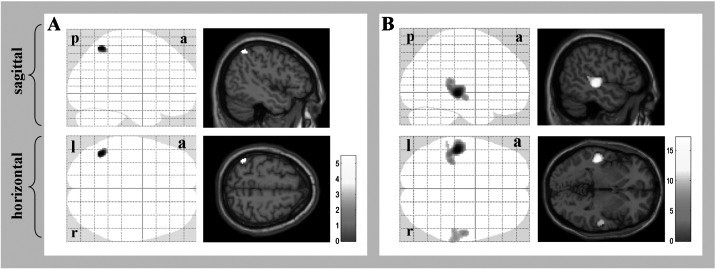
Figure 2. Brain scan
(A) This image indicates a region with significant activation in the IPC upon auditory stimulations
in the brain of synesthetes.
(B) Moreover, two regions at the left and right temporal lobe showed increase
in activation in synesthetes during auditory stimulations.
(A) This image indicates a region with significant activation in the IPC upon auditory stimulations
in the brain of synesthetes.
(B) Moreover, two regions at the left and right temporal lobe showed increase
in activation in synesthetes during auditory stimulations.
2.2 Chromesthesia
Synesthesia is a very interesting phenomenon with chromesthesia being one of the most interesting forms. For some sound can evoke sensation of seeing colors. Other individuals can see music on a "screen" in front of their eyes. For others certain sounds can induce sensations in parts of the body.
Researchers have concluded that chromesthesia affects nearly all of us. There is a trend that people tend to choose darker colors for lower pitch noises rather then light colors and all the way around. That means that we all have mechanisms inside us that links music to an image.
Secondly there are even more obvious evidences of synesthesia - when sound is described by visual and physical measures, hence low notes and high notes.
Researchers have concluded that chromesthesia affects nearly all of us. There is a trend that people tend to choose darker colors for lower pitch noises rather then light colors and all the way around. That means that we all have mechanisms inside us that links music to an image.
Secondly there are even more obvious evidences of synesthesia - when sound is described by visual and physical measures, hence low notes and high notes.
For instance in Bali and Java: pitches are not low and high but large and small. This is a very natural attribution, which can be found in our everyday experience. For example, we never expect a low sound projecting from a very small object or the other way around. [7]
Even different tempos can cause a sensation of chromesthesia. Dr. Emily Freeman [8] in 2003 did a study on an audience using the pieces of music played in three different tempos. The study showed that tempo significantly affects the color associations made while listening to the same piece of music on different tempos [9]. Nevertheless musical sounds also include two other components: the pitch (it is often characterized as "weight" of the sound) and its timbre. Metaphors are frequently used to describe the pitch or timbre. The word bright is used to describe the quality of sound; therefore it is implying that these musical components have a color content that is used in a musical practice.
Even different tempos can cause a sensation of chromesthesia. Dr. Emily Freeman [8] in 2003 did a study on an audience using the pieces of music played in three different tempos. The study showed that tempo significantly affects the color associations made while listening to the same piece of music on different tempos [9]. Nevertheless musical sounds also include two other components: the pitch (it is often characterized as "weight" of the sound) and its timbre. Metaphors are frequently used to describe the pitch or timbre. The word bright is used to describe the quality of sound; therefore it is implying that these musical components have a color content that is used in a musical practice.
[7] Anvari, S. “Composing Music Based on Carpet.” 2014
[8] Professor and director of orchestral activities in the Bowling Green State University.
[9] Freeman, E. M. "The Effect of tempo and tonality on the color associations of elementary children", Missouri Journal of Research in Music Education (40), 2003. p. 46-59
[8] Professor and director of orchestral activities in the Bowling Green State University.
[9] Freeman, E. M. "The Effect of tempo and tonality on the color associations of elementary children", Missouri Journal of Research in Music Education (40), 2003. p. 46-59
2.2 Chromesthesia
Synesthesia is a very interesting phenomenon with chromesthesia being one of the most interesting forms. For some sound can evoke sensation of seeing colors. Other individuals can see music on a "screen" in front of their eyes. For others certain sounds can induce sensations in parts of the body.
Researchers have concluded that chromesthesia affects nearly all of us. There is a trend that people tend to choose darker colors for lower pitch noises rather then light colors and all the way around. That means that we all have mechanisms inside us that links music to an image.
Secondly there are even more obvious evidences of synesthesia - when sound is described by visual and physical measures, hence low notes and high notes.
Researchers have concluded that chromesthesia affects nearly all of us. There is a trend that people tend to choose darker colors for lower pitch noises rather then light colors and all the way around. That means that we all have mechanisms inside us that links music to an image.
Secondly there are even more obvious evidences of synesthesia - when sound is described by visual and physical measures, hence low notes and high notes.
For instance in Bali and Java: pitches are not low and high but large and small. This is a very natural attribution, which can be found in our everyday experience. For example, we never expect a low sound projecting from a very small object or the other way around. [7]
Even different tempos can cause a sensation of chromesthesia. Dr. Emily Freeman [8] in 2003 did a study on an audience using the pieces of music played in three different tempos. The study showed that tempo significantly affects the color associations made while listening to the same piece of music on different tempos [9]. Nevertheless musical sounds also include two other components: the pitch (it is often characterized as "weight" of the sound) and its timbre. Metaphors are frequently used to describe the pitch or timbre. The word bright is used to describe the quality of sound; therefore it is implying that these musical components have a color content that is used in a musical practice.
Research that I came across by Paul A. Haack [10] (1981) was a case study of a chromesthetic phenomena that is involving following pitch-color relationships that are experienced consistently in A Major (See the Table).
Other well-studied case by Dr. Haack involved an art teacher who had a range of consistent linkages between a tone and a color. For her, high octaves tended to evoke a lighter color value, while lower octaves evoked a darker color value. And a rapid major chord tone sequences elicited rapid flashes of colors, "somewhat like fireworks exploding” [11].
[7] Anvari, S. “Composing Music Based on Carpet.” 2014
[8] Professor and director of orchestral activities in the Bowling Green State University.
[9] Freeman, E. M. "The Effect of tempo and tonality on the color associations of elementary children", Missouri Journal of Research in Music Education (40), 2003. p. 46-59
[8] Professor and director of orchestral activities in the Bowling Green State University.
[9] Freeman, E. M. "The Effect of tempo and tonality on the color associations of elementary children", Missouri Journal of Research in Music Education (40), 2003. p. 46-59
[10] Paul Haack. professor of music education at the University of Minnesota.
[11] Haack, P. A., & Radocy, R. E. “A case study of a chromesthetic. Journal of Research in Music Education”, 29, 1981. p. 85-90.
[11] Haack, P. A., & Radocy, R. E. “A case study of a chromesthetic. Journal of Research in Music Education”, 29, 1981. p. 85-90.
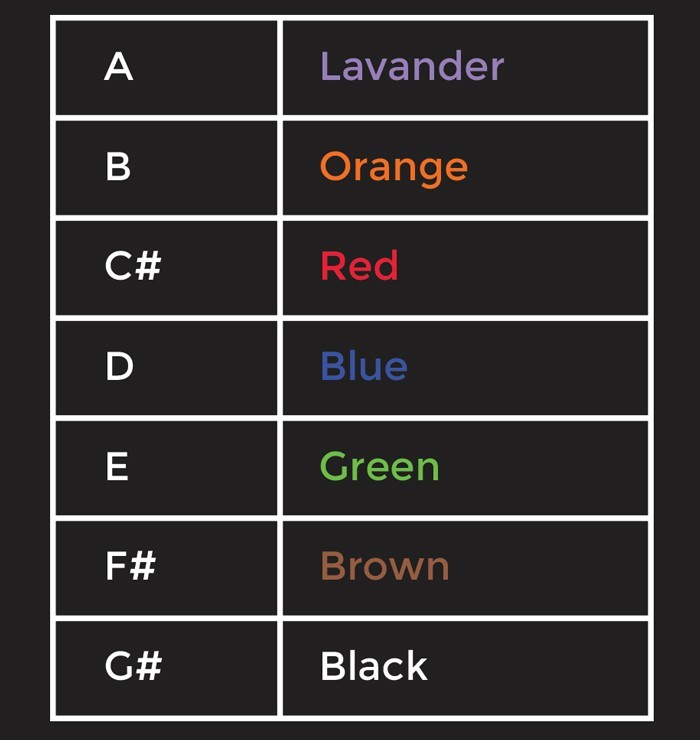
Table by Paul A. Haack
2.3 Synesthetic experiences in art
We see the synesthetic experience particularly in all forms of art like: poetry, painting, sculpture and music. Synesthesia makes a link from one sensory domain to another; likewise we assume that creativity is an ability to make unique connections between different concerns and ideas (figure 3).
"Synesthesia is seven times more common among artists, novelists and poets, and creative people in general," says neuroscientist Dr. Ramachandran, "artists often have the ability to link unconnected domains, have the power of metaphor and the capability of blending realities." [12]
"Synesthesia is seven times more common among artists, novelists and poets, and creative people in general," says neuroscientist Dr. Ramachandran, "artists often have the ability to link unconnected domains, have the power of metaphor and the capability of blending realities." [12]
Music is a special symbiotic model of art; all the components are gathered in one container of the musical piece. Music allows expressing personal emotions, sensations and feelings in one unifying media of a sound. So music already by its essence is something really close to the concept of synesthetic sensation
Synesthesia: When Senses Collide, BBC UK 2008

Figure 3. Hans Arp – Untitled (1916–1917)
Collage of torn papers on paper. This difficult art of meaninglessness often completely relies on subconscious choices as synesthetic experiences.
Collage of torn papers on paper. This difficult art of meaninglessness often completely relies on subconscious choices as synesthetic experiences.
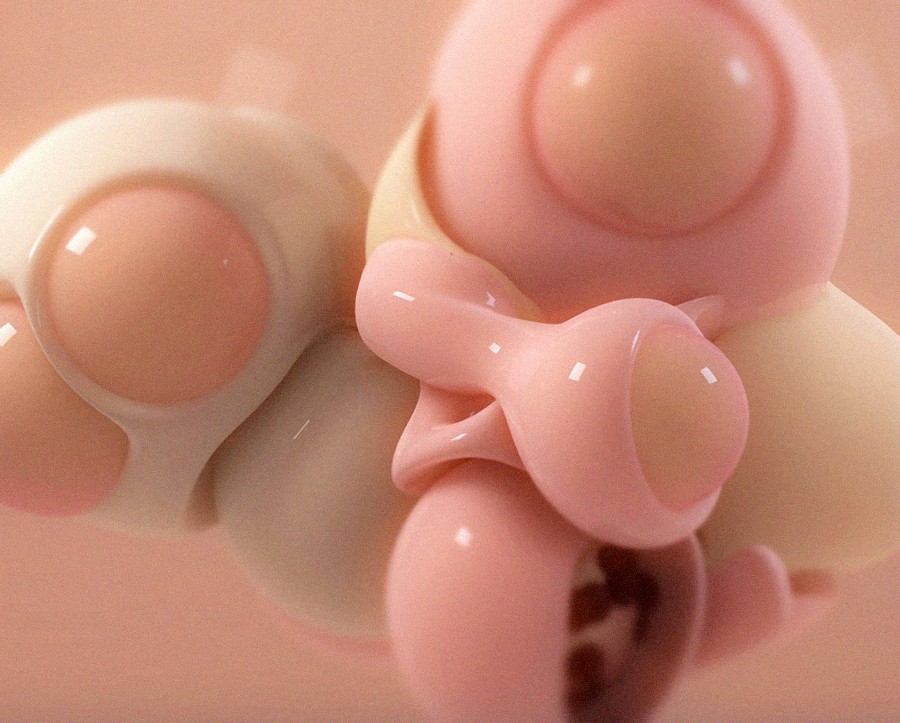
Figure 4. Quasi-Objects / C Studies (2010-2011)
According to the artist the meaning of his random 3d generated videos and prints are to stimulate thoughts and dialogue on the progressive relativisation of natural forms and their textures and colors.
According to the artist the meaning of his random 3d generated videos and prints are to stimulate thoughts and dialogue on the progressive relativisation of natural forms and their textures and colors.
2.4 “The man who heard his paint box hiss”
"Colour is the keyboard. The eye is the hammer. The soul is the piano with its many strings." [13]
Wassily Wassilyevich Kandinsky (1866–1944) was an influential Russian painter and art theorist. He is often credited for creating the first truly abstract paintings. While writing that music is the ultimate teacher, Kandinsky believed that he could possibly evoke a sound through the sight and create a painting that would equivalent to a symphonic music. This art would stimulate not just the viewer’s eyes but also ears. For Kandinsky music and color were tightly tied together. Music played an important role in Kandinsky’s abstract paintings and life. The famous Viennese composer Arnold Schönberg was a big influence in his works. Schönberg abandoned tonal and harmonic conventions in his compositions the same way that Kandinsky rejected the figure or recognizable object in favor of shapes, lines, and clashing colors in his work. He used color, line, shape, and texture to create a rhythmic visual experience that evoked an emotional response. Kandinsky could see colors when he heard music, and hear music when he painted. He once described his discovery of synesthesia that occurred during an opera performance in Moscow:
“I saw all my colors in spirit, before my eyes. Wild, almost crazy lines were sketched in front of me.” [14]
Wassily Wassilyevich Kandinsky (1866–1944) was an influential Russian painter and art theorist. He is often credited for creating the first truly abstract paintings. While writing that music is the ultimate teacher, Kandinsky believed that he could possibly evoke a sound through the sight and create a painting that would equivalent to a symphonic music. This art would stimulate not just the viewer’s eyes but also ears. For Kandinsky music and color were tightly tied together. Music played an important role in Kandinsky’s abstract paintings and life. The famous Viennese composer Arnold Schönberg was a big influence in his works. Schönberg abandoned tonal and harmonic conventions in his compositions the same way that Kandinsky rejected the figure or recognizable object in favor of shapes, lines, and clashing colors in his work. He used color, line, shape, and texture to create a rhythmic visual experience that evoked an emotional response. Kandinsky could see colors when he heard music, and hear music when he painted. He once described his discovery of synesthesia that occurred during an opera performance in Moscow:
“I saw all my colors in spirit, before my eyes. Wild, almost crazy lines were sketched in front of me.” [14]
Kandinsky heard his paint box hissing while mixing different colors of paint. Here Wassily Kandinsky describes his favorite color (Figure 5):
“The deeper the blue becomes, the more strongly it calls man towards the infinite, awakening in him a desire for the pure and, finally, for the supernatural… The brighter it becomes, the more it loses its sound, until it turns into silent stillness and becomes white." [15]
It’s clear that this man saw more in a color than the non-synesthetes and even synesthetes .
To him, a color was more than a quality of an object, or adjective. He thought colors had its own meaning, its own depth, its own purpose and texture.
“The deeper the blue becomes, the more strongly it calls man towards the infinite, awakening in him a desire for the pure and, finally, for the supernatural… The brighter it becomes, the more it loses its sound, until it turns into silent stillness and becomes white." [15]
It’s clear that this man saw more in a color than the non-synesthetes and even synesthetes .
To him, a color was more than a quality of an object, or adjective. He thought colors had its own meaning, its own depth, its own purpose and texture.
[13] Kandinsky, Wassily, Franz Marc, and Klaus Lankheit (2004), El Jinete Azul: Der Blaue Reiter. Barcelona: Paidós.
[14] http://www.anyagerasimchuk.com/music&art_article.html
[15] http://www.telegraph.co.uk/culture/art/3653012/The-man-who-heard-his-paintbox-hiss.html
[14] http://www.anyagerasimchuk.com/music&art_article.html
[15] http://www.telegraph.co.uk/culture/art/3653012/The-man-who-heard-his-paintbox-hiss.html
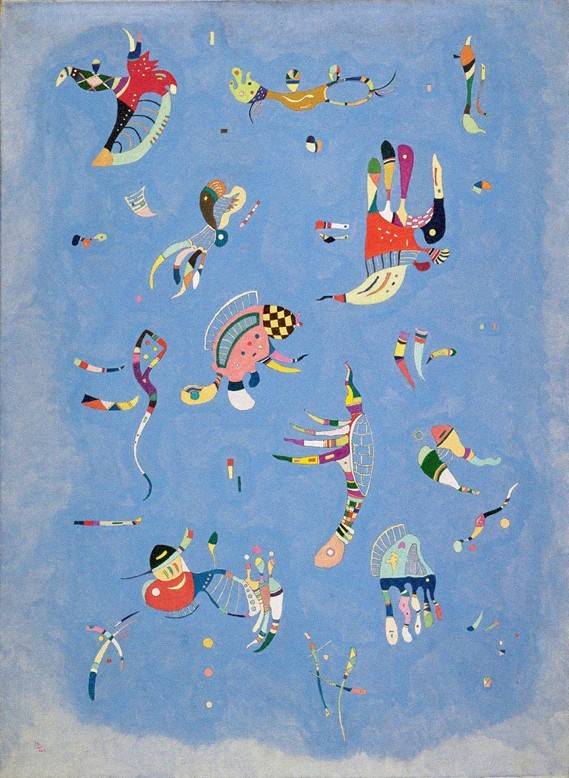
Figure 5. Wassily Kandinsky - Sky Blue. 1940
Oil on canvas. 100х73 cm
Oil on canvas. 100х73 cm
2.5 Visual Rhythms of Piet Mondrian
Mondrian's spirituality and love for the music profoundly influenced his work and, ultimately, the art world by that time. Mondrian's paintings have a lot of different mediums of inspirations. Starting from the subway map of the city till the music and dance moves of boogie-woogie. It is possible to sense pulsing and lively rhythm of music. His latest paintings (Figure 6) are an allegory of a colorful music of dynamic lines, contrasts and optical vibrations.
Mondrian was fascinated by American jazz, particularly boogie-woogie. In his painting he was looking syncopated beat, irreverent approach to melody, and improvisational aesthetic. You can sense stuttering chromatic pulses, interrupted by light gray, create paths across the canvas suggesting the city's grid, the movement of traffic, and blinking electric lights, as well as the rhythms of jazz. [16]
[16] http://www.moma.org/collection/browse_results.php?object_id=78682
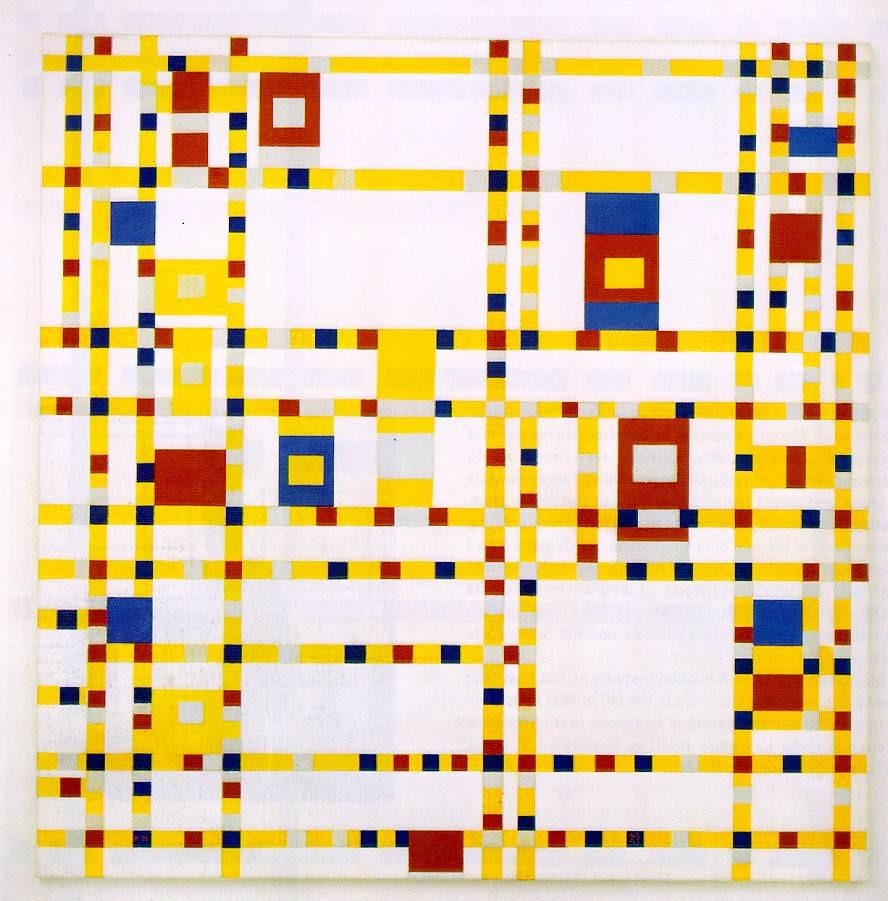
Figure 6. Piet Mondrian - Broadway Boogie Woogie. 1942-43
2.6 The “ticket” to the meaningful image
Artist gives us a "ticket" to experience reality of artist’s concept or statement. This "ticket" gives us shared synesthetic experiences, because the power of meaningful art is to extend our horizon of the perception.
Synesthesia can help to understand the mind of an artist; I would call it a “ticket” to the artists mind. This “ticket” along with metaphors also is another proof of a link between the creativity and this neurological phenomenon. Indeed art is an extension of the function of the brains. As an illustration — in the modern art perception precedes meaning, and medium precedes message, but our synesthetic abilities help us to find that meaning with ease.
Synesthesia can help us to understand difficult concepts and abstract artworks, beside that it also can help creating the right atmosphere. For examples it can be used as a concept for a light choreography during a concert. As I mentioned in my research there is a certain color-sound link in everyone’s brains, despite being a synaesthete or not. Also it is generally accepted in synesthetic studies that the faster the music, the sharper and more angular is the visual image. I believe these associated colors and visuals with the various harmonic tones can help listener to trigger cooperation of senses.
Synesthesia can help to understand the mind of an artist; I would call it a “ticket” to the artists mind. This “ticket” along with metaphors also is another proof of a link between the creativity and this neurological phenomenon. Indeed art is an extension of the function of the brains. As an illustration — in the modern art perception precedes meaning, and medium precedes message, but our synesthetic abilities help us to find that meaning with ease.
Synesthesia can help us to understand difficult concepts and abstract artworks, beside that it also can help creating the right atmosphere. For examples it can be used as a concept for a light choreography during a concert. As I mentioned in my research there is a certain color-sound link in everyone’s brains, despite being a synaesthete or not. Also it is generally accepted in synesthetic studies that the faster the music, the sharper and more angular is the visual image. I believe these associated colors and visuals with the various harmonic tones can help listener to trigger cooperation of senses.
Since each synesthete has a unique color palette of experiences it triggers me to think of an interactive music visualization tool, which is based on the listener’s preferences and abilities to interact with heard sounds. This tool could process different imagery created by different listeners along the same musical piece.
I perceive musical visualization as a form of transmission between a musician, a visual artist and a listener. It is a form of communication that is beyond the usual forms of a communication. Synesthesia can increase efficiency of this transmission. Furthermore synesthetic experience is not seeing with your eyes but with your mind. By linking synesthetic experiences to each other it is possible to create an artwork that breaks boundaries between seeing and hearing and expands the reach of our sensorial perception.
I perceive musical visualization as a form of transmission between a musician, a visual artist and a listener. It is a form of communication that is beyond the usual forms of a communication. Synesthesia can increase efficiency of this transmission. Furthermore synesthetic experience is not seeing with your eyes but with your mind. By linking synesthetic experiences to each other it is possible to create an artwork that breaks boundaries between seeing and hearing and expands the reach of our sensorial perception.